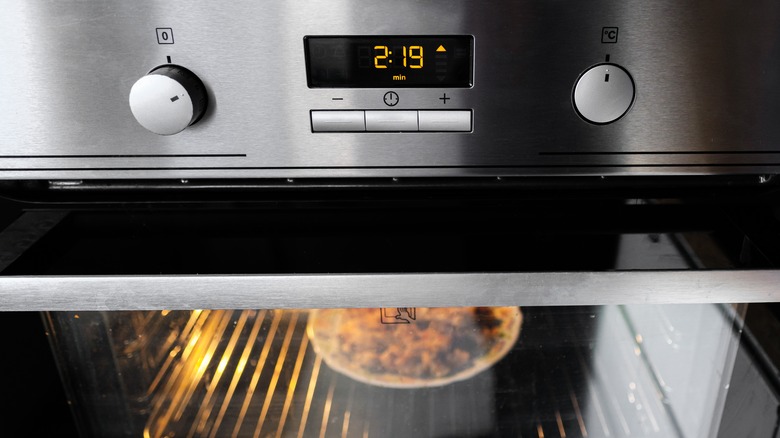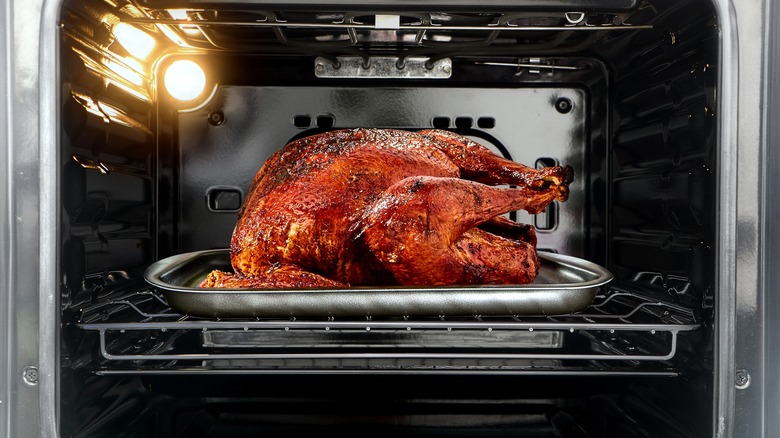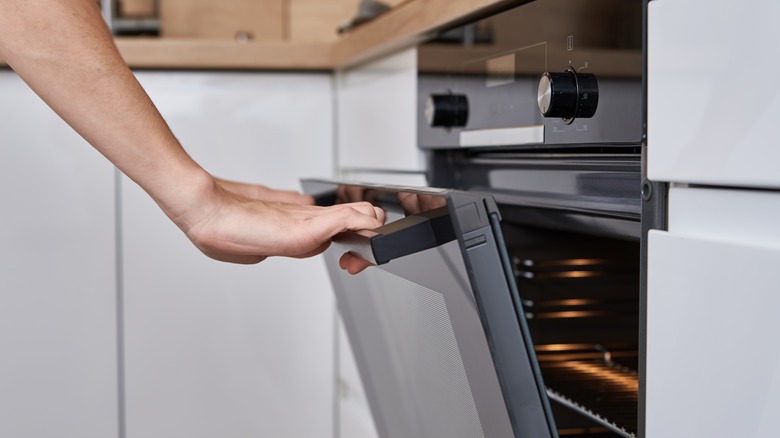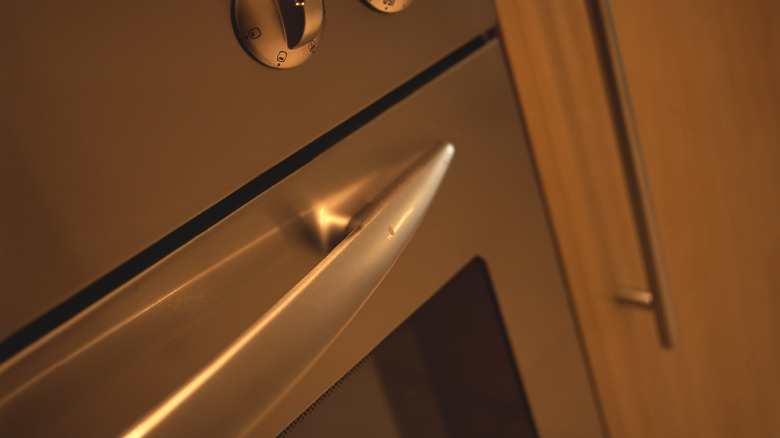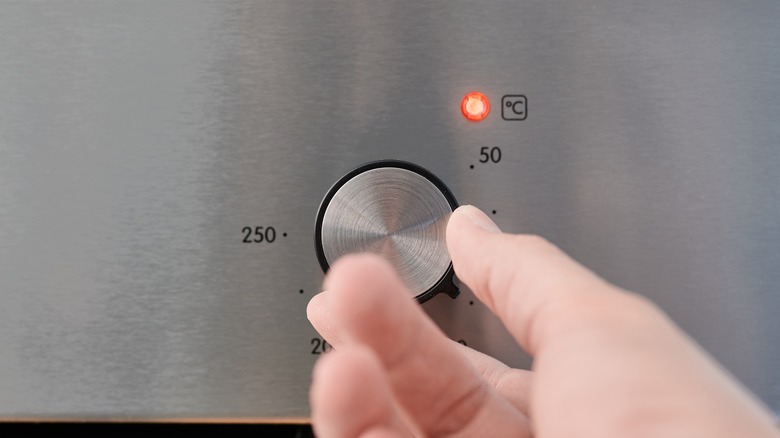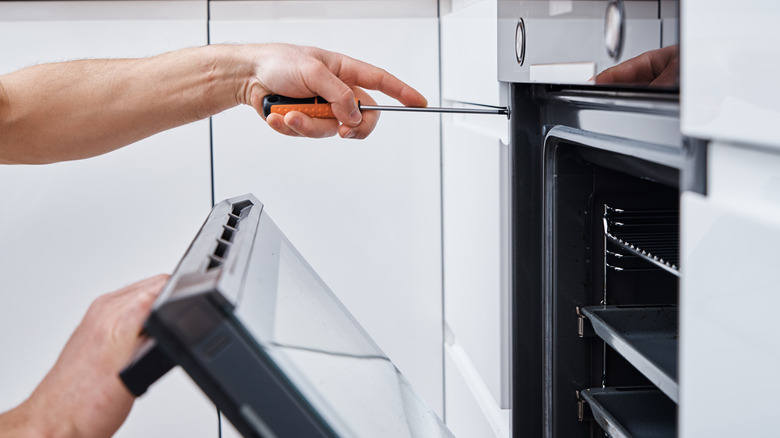Why Your Oven Isn't Cooking Food Evenly, According To An Expert
Cooking with an oven is often an efficient and comforting process. Whether baking cookies or completing a family meal for dinner, these kitchen staples often play a central role. The U.S. Energy Information Administration reports that the average American household uses these appliances to prepare a meal roughly three times a week, making them an essential resource in most homes. Unlike pan frying or broiling, which cooks food using direct heat, ovens heat the air inside a chamber to gradually raise the temperature of a dish. Unfortunately, while this process usually results in evenly cooked food, certain problems can make this method a little less certain.
If your oven isn't working correctly, it may suffer from uneven temperature disbursal. This is a problem that convection models (those with a fan on the back wall) aim to solve but are often just as susceptible to. In an exclusive interview with House Digest, Jeff Russell, the owner of Diamond Factory Service in Kansas City, Missouri, outlines a few essential clues to help you solve the mystery. Oven technology is relatively straightforward, so trouble with the cooking process is likely due to one of just a few primary culprits. Often, the trouble can be diagnosed and fixed with ease.
Uneven temperature distribution
The primary issue that oven cooking addresses is the uneven distribution of heat. Both mechanical malfunctions and user error can lead to trouble. "Uneven temperature distribution occurs when one part of the oven is hotter than another, resulting in food that is cooked differently across different sections," Russell notes. "Temperature variations can happen for numerous reasons, including insufficient preheating, incorrect calibration, blocked vents, or issues with the heating elements."
Uneven temperatures inside the cooking chamber can make batch cooking a major hassle. For example, if you're baking cookies, a temperature gradient inside the unit can leave those on the highest racks finished in the prescribed time while those at the bottom remain raw. Fixing this problem is, therefore, a must for anyone who uses this appliance regularly. "To ensure even cooking results, make sure your oven is properly preheated before use. If possible, you may also want to invest in an oven thermometer to monitor and adjust the temperature as needed. Additionally, consider investing in an oven shield to help reduce turbulence," Russell says.
The heating element is damaged
If you're experiencing uneven cooking, it may be due to a problem with the heating element itself. "A defective heating element will not be able to properly heat up the entire oven, resulting in temperature fluctuations that can affect the quality of your food," says Russell.
"To prevent this from happening," he continues, "make sure to regularly check and clean your oven's heating elements. If you notice any discoloration or burn marks, replace them as soon as possible. Additionally, cleaning any dirt or grease buildup can help improve air circulation and increase efficiency. If you have an electric oven with coil heating elements, make sure they are secured tightly in place and not touching each other."
Fortunately, the heating element is entirely replaceable, so a quick fix can be brought about if the cooking imbalance is due to the heat source. Similarly, evaluating this feature is quick and easy. There's no digging around that must be done or care of fragile parts that need to be taken to diagnose an issue with the heating element.
The seal around the door is worn out
An improperly sealed door will allow heat to escape from the oven and leave the front edge of the box noticeably cooler than the remainder of the oven. If one side of your casserole is overcooked while the other side is perfect, it's definitely worthwhile to check the seal. "A broken or damaged seal prevents heat from escaping, leading to hotter temperatures on one side of the oven than the other. This can make it difficult to achieve consistent results from your recipes, as certain portions may be cooked more quickly than others," says Russell.
Russell notes that a homeowner should "regularly inspect the seal around your oven door and replace it if needed." It's also worth considering that air circulation is a crucial feature of even heating. So cramming your oven to capacity is probably not the best idea, especially if your oven is suffering from a defective seal. "Additionally," Russell says, "make sure that you aren't overloading your oven with too much food as this can also reduce airflow and cause uneven heating."
The thermostat is old or unreliable
If your oven door and heater seem to be working correctly, you may be experiencing the result of faulty components. "A compromised thermostat may not be able to accurately measure and maintain the correct temperature inside the oven, resulting in fluctuations that can affect the cooking results," Russell says.
"To avoid this problem," he continues, "make sure that you inspect and calibrate your oven's thermostat on a regular basis. If needed, replace it with a new one as an older model might not be capable of providing accurate readings."
Like many other electrical components in an appliance, the thermostat relies on a control board, relay signals, and wiring. Over time, extreme heat changes can cause your wiring and other thermostat essentials to wear out. This may result in the temperature control feature losing its calibration and effectiveness. Thankfully, repairing or replacing the thermostat can bring the oven back up to the standard you seek from the culinary tool.
When to call the professionals
Your oven's problems may extend beyond your capabilities, and that's nothing to be ashamed of. Calling a technician to deal with the problems you've found or to identify them is the best way to attack the issue at its source. "If all else fails, hire a professional technician to look at your oven and fix any issues with any of the components. They will be able to accurately diagnose and address the problem so that you don't have to worry about uneven cooking results in the future," says Russell.
It's also possible that you'll get expert advice surrounding an oven replacement. Professionals know when it's time to throw in the towel on an appliance, even when homeowners can't see the scope of the issue. A repair professional can give you an honest opinion on your oven's health and potential lifespan. Chances are that your unit can benefit from a simple fix, but it's always worth getting a second opinion if you've had many problems with the unit or if it's particularly old.
